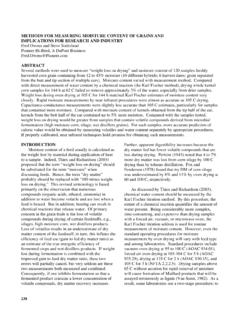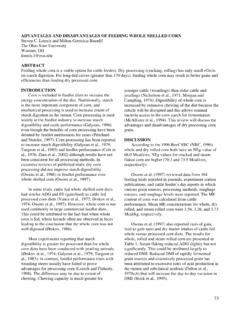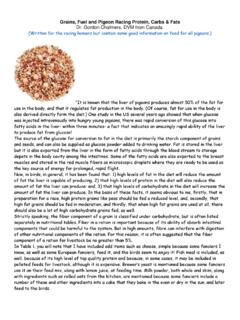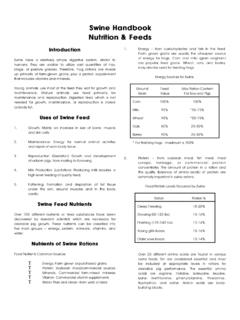Transcription of NUTRIENT COMPOSITION OF UNPROCESSED …
1 26 NUTRIENT C OMPOSITION OF UNPROCESSED GRAINS AND P ROCESSED GRAINS Larry L. Berger, Department of Animal Sciences University of Illinois ABSTRACT NUTRIENT COMPOSITION of commercial corn grain appears to have changed little in the last 10 to 15 years. Although the data for sorghum grain and barley are more limited, no dramatic changes in NUTRIENT COMPOSITION were apparent. Flaking corn appears to reduce the crude protein concentrations, perhaps because water used for starch gelatinization is not released during drying. Harvesting and storing corn grain as high-moisture increases the protein solubility and rumen degradation of corn grain protein. In contrast, flaking corn decreases protein solubility and ruminal protein degradation.
2 Flaking corn may increase phosphorus availability by increasing ruminal phytase activity. INTRODUCTION NUTRIENT COMPOSITION of grains can be quite variable. Although the variation is less with grains than with forages or byproduct feeds, grains comprise the majority of most feedlot diets so small changes in NUTRIENT COMPOSITION become very important. The sources of variation in NUTRIENT COMPOSITION can be divided into processing and non-processing factors. Most of the processing effects relate to energy value of the grains. Because several speakers have discussed how processing variables affect the energy values of different grains, that topic will not be discussed here. Effects of processing on protein and mineral availability will be discussed later.
3 NON-PROCESSING VARIATION Non-processing factors that can affect the NUTRIENT COMPOSITION of grains include, but are not limited to, year, variety, fertilization, and management factors. In the last 10 to 15 years grain producers have made substantial changes in varieties (genetics), fertilization programs, and management practices. This review will examine whether such changes ha ve altered grain COMPOSITION . grain NUTRIENT COMPOSITION data collected for the 1996 Beef NRC publication (NRC, 1996) were from grains produced in the early 1990s. Data were collected from approximately 40 different laboratories in North America. grain samples from most states and Canadian provinces were included in th at database.
4 The Dairy One feed analysis laboratory in Ithaca, New York provides excellent public access to a database that can be used to examine NUTRIENT variation. This laboratory receives grain samples from throughout the United States and Canada. These data have not been screened to remove outliers, so the standard deviations are greater than found in other data sources. The Dairy One data base is robust because it contains a large number of samples analyzed for many nutrients that were received between May 2000 and June 2006. All nutrients are expressed on a dry matter basis and can be accessed at Through comparing the NUTRIENT COMPOSITION data from the 1996 Beef NRC and the current Dairy One database, large changes in NUTRIENT profile over the last 10 to 15 years can be detected.
5 Corn is the primary g rain fed to cattle and has the largest number of samples in the data base. With over 3500 samples in both data sets, corn in the Dairy One data set averaged crude protein; in the early 1990s corn averaged protein (Table 1). Whether this is a trend or just random variation, is impossible to determine. However, when we select corn varieties for increased yield or alcohol production, a decrease in protein concentration would not be surprising. Based on more than 2200 samples, corn NDF values also have tended to decrease ( vs. ) during the past 15 years. Since most of the fiber is in the seed coat, it is possible that as we select for increased yield, kernel size could increase resulting in the seed coat being a smaller fraction of the weight.
6 27 Table 1. Current corn NUTRIENT COMPOSITION compared with that reported in the 1996 Beef NRC Dairy Onea 1996 Beef NRC Item N Mean Std. N Mean Std. Dev. Dry matter % 4135 3708 Crude protein % 3578 3579 Ether extract, % 1829 134 Neutral detergent fiber, % 2250 2488 Calcium, % 1923 3516 Phosphorus, % 1916 3515 Magnesium, % 1902 3437 Potassium, % 1906 3437 Sulfur, % 1451 382 Zinc, ppm 934 1743 Copper, ppm 934 1743 Manganese, ppm 926 1741 bStandard deviation. Mean mineral concentrations were very similar for corns raised in the early 1990s and those analyzed in more recent years (Table 1).
7 In general, the standard deviations tended to be larger for the Dairy One data set than was reported in the 1996 Beef NRC. It is not known whether the mineral content of corn is becoming more variable, or whether some samples in the Dairy One data set may have been contaminated with other grains. Sorghum grain is the second most common grain fed to cattle in the Because of the small number of samples analyzed, it is more difficult to detect compositional changes (Table 2). Mean crude protein has decreased from in the 1996 Beef NRC to in the current Dairy One database. With only 128 samples assayed for crude protein in the current data, one must be cautious about concluding that sorghum grain protein concentrations are decreasing.
8 Mineral concentration data were not compared because of the small number of samples analyzed. Table 2. Current sorghum grain NUTRIENT COMPOSITION compared with that reported in the 1996 Beef NRC Dairy Onea 1996 Beef NRC Item N Mean Std. N Mean Std. Dev. Dry matter, % 147 226 Crude protein, % 128 230 Ether extract, % 58 68 Neutral detergent fiber, % 109 7 bStandard deviation. Barely is fed commonly to cattle in the Northern and Canada. Mean crude protein concentrations of barely decreased from to between the early 1990s and the current samples (Table 3). With 769 and 1884 samples for the Dairy One and Beef NRC data sets respectively, this difference may be of actual trends.
9 In contrast, mean NDF concentrations tended to increase ( vs. ) over the past 15 years. Drought stress that has occurred in the barley producing areas of the the past few years may explain this trend. 28 Table 3. Current barley NUTRIENT COMPOSITION compared with that reported in the 1996 Beef NRC Dairy Onea 1996 Beef NRC Item N Mean Std. N Mean Std. Dev. Dry matter, % 992 1743 Crude protein, % 769 1884 Ether extract, % 492 8 Neutral detergent fiber, % 627 1216 bStandard deviation. PROCESSING VARIATION Processing of grains would not be expected to change NUTRIENT concentrations. However, analysis of 3,578 samples of cracked corn, 10,350 samples of high-moisture corn, and 278 samples of flaked corn, revealed, crude protein concentrations that averaged , , and , respectfully in the Dairy One database.
10 Flaking should not volatilize nitrogen resulting in a reduction in crude protein. However, testimonials indicate that flaking will lower crude protein concentrations. It is possible that during starch gelatinization, water is added to the starch matrix that is not lost during drying. Measured as an increase in dry weight, this would dilute the nitrogen and thereby reduce the crude protein concentration. An increase in mass of would be required to dilute the protein from to An increase in weight of this magnitude seems unlikely. The relatively low number of flaked corn samples (278) may be part of the explanation. However, region of origin of the flakes, selection for high test weight, using high starch hybrids for flaking, scalping of grain prior to flaking, and un-representative sampling of flakes, also might be involved.






